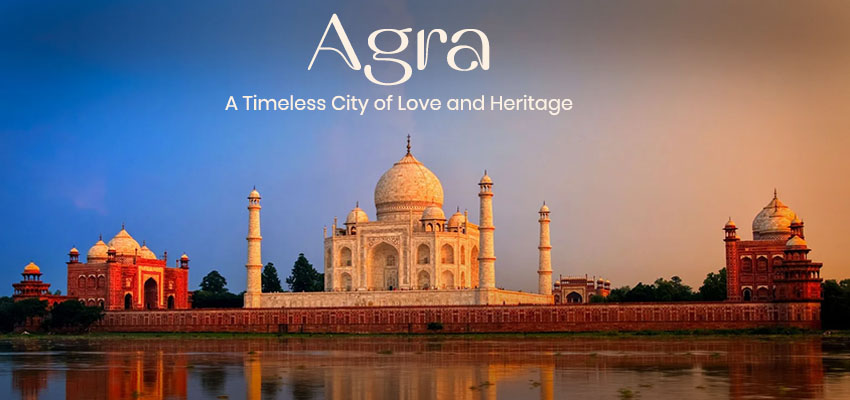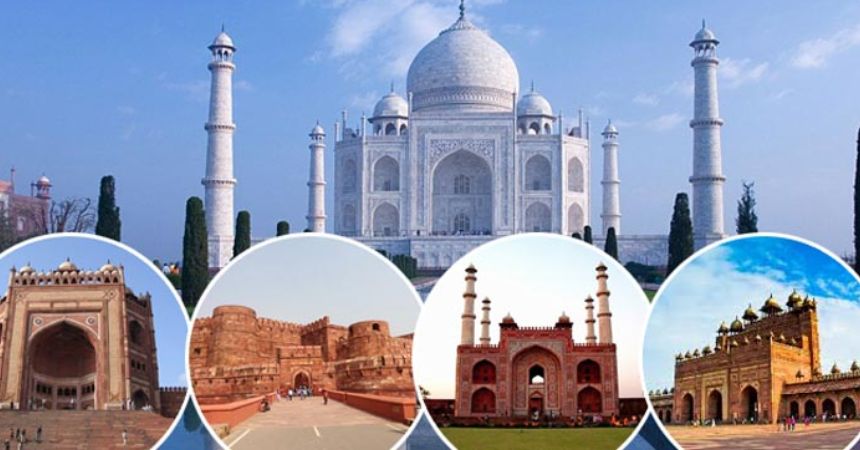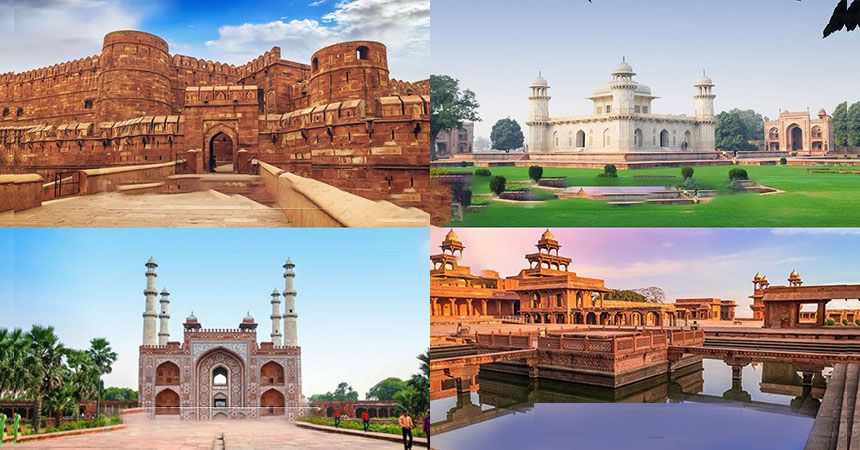Agra: A Timeless City of Love and Heritage

Agra is one of the most famous cities in the world and is well-known for its history and masterful architecture. It is located in the northern part of India and was the capital of the Mughal Empire during the rule of Akbar, Jahangir, and Shah Jahan. The city is famous for the Taj Mahal and is blessed with incredible Mughal architecture. This blend of history gave Agra its significant contribution to Indian culture. After all, architecture and art flourished during the Mughal Era.
The Significance of Agra
There is a great share of Indian history that Agra provides to its visitors, a special place to explore in India. Agra was the heart of the Indian subcontinent’s culture and art during the golden period of the Mughals. As a result of this, the city is famous for its exceptional Mughal architecture and legacy of monumental buildings that are a delight to the eyes. Agra has significant historical, religious, and cultural value. For both Muslims and Hindus, Agra holds important religious landmarks which makes the city rich in culture.
Tourism in Agra: A Heritage Experience
The economy of Agra is primarily based on tourism which contributes to millions of visitors eager to know more about the intricate history of the city and tourist sites. Agra's tourism is highly dependent on its historical landscape which has been designed marvelously and creates wonder for all its viewers. People visiting Agra are usually drawn to its Taj Mahal, which happens to be one of the Seven Wonders of the World, alongside many other magnificent structures located in the city. People then also visit the forts, tombs, and palaces which showcase the beauty of the Mughal civilization. On top of all of this, Agra is also known for its busy bazaars where tourists can purchase handmade crafts, leather, jewellery, and textiles which attracts more and more visitors. The importance of tourism in Agra is helpful in fostering the economy of the city, however, it also increases global understanding of the country's rich cultural heritage. Agra has become the center not just for historians and architects, but, for artists, and other people who want to capture the beauty of the city.What Makes Agra Special?

- The Taj Mahal: The stunning white marble mausoleum of the Taj Mahal was built by Emperor Shah Jahan in memory of his wife Mumtaz Mahal. This stunning piece of architecture is considered one of the finest examples of Mughal architecture and is famous across the globe due to its Taj Mahal grandeur. In addition to these features, the Taj Mahal possesses beautiful intricate carvings, breathtaking gardens, and symmetrical patterns making it one of the best places to visit in India.
- Mughal Architecture: Agra’s rich and intense diverse history can be seen in Agra Fort and Fatehpur Sikri where their beauty tells tales of the Mughal Empire. The structure and style used are a mixture of Islam, Persia, and India, which makes it attractive from a distance and worthy from a perspective of history and heritage.
- Rich History: Agra’s past is well preserved from the reign of the Afghanistan Empire up until the British Raj. From Agra and Indian culture as a whole, there is a lot to learn and explore and the influence of the British Empire is just another strand in the complex heritage of this beautiful country.
- Cultural Heritage: Agra is famous for its classic art forms such as marble in-lay, leather goods, and handmade jewellery pieces. The local markets of the city allow tourists to purchase one of these fine pieces of art, a great number of which have been created through methods taught over many years.
- Local Cuisine: Agra's culinary heritage offers distinct types of North Indian and Mughlai dishes. Be it the kebabs and biryanis, or sweets like pethas (a local specialty), the city is a delight for food lovers. In addition to its rich history, Agra has a lively street food culture where visitors can relish Indian fast-food snacks.
Best Time to Visit Agra: Season vs. Off-Season
Agra has a semi-arid climate with hot summers, monsoons, and moderately cool winters. The overall experience can vary depending on the period of your visit.- Winter (October to March): Among all others, the winter months are ideal for tourism in Agra. Sightseeing becomes very enjoyable due to the cool weather that ranges from 10°C to 25°C (50°F to 77°F). As is true for most tourist locations, this is also the peak visiting season, meaning larger crowds can be expected during holidays and festival seasons like Diwali and Christmas. Nevertheless, it is a good time of the year to explore the city’s historic attractions without excessive sweating.
- Summer (April to June): In Agra, Summers can get really intense with temperatures often exceeding 40 degrees Celsius. The heat can be unbearable for tourists, especially during outdoor site visits such as the Taj Mahal. However, during this time of the year, there is a dip in tourism and hence, lower prices on hotels and accommodations. If you decide to travel during summer, be sure to check out Agra during early morning, or around sunset when temperatures are much more pleasant.
- Monsoon (July to September): During monsoons, Agra receives heavy showers, which makes it ideal for outdoor sightseeing. Traveling can be very uncomfortable due to the heightened level of humidity. But the pouring rains nourish the land and the view of the Taj Mahal with its stunning reflection on the drenched marble exudes beauty. So, if you do not mind getting wet, Agra can be visited around this time for a quieter experience away from larger crowds. There is great off-season value in hotels and attractions during this time.
Major Places to Visit in Agra
 When it comes to Agra, there are countless magical sites to behold that highlight its rich history and culture. Here are some places that should not be missed on your visit to Agra.
When it comes to Agra, there are countless magical sites to behold that highlight its rich history and culture. Here are some places that should not be missed on your visit to Agra.
- Taj Mahal: The Taj Mahal Agra's crown jewel, is the epitome of love and a UNESCO World Heritage Site. The mausoleum of the Taj Mahal adorned in white is surrounded by gardens, reflecting pools, and carvings. It is the top attraction of the city and one of the most visited monuments in the world.
- Agra Fort: The Agra Fort is a beautiful fusion of Mughal Art and Construction which is also a UNESCO World Heritage Site. Built with red sandstone, the colossal fort is the palace of Akbar the Great and comprises a number of rooms and mosques along with a major courtyard. The Taj Mahal can be seen from its walls.
- Fatehpur Sikri:Agra's Fatehpur Sikri was earlier a Mughal Capital City and now serves as a tourist destination. The red sandstone pillars of the site include the grand gateways which are the Buland Darwaja also known as the Grand door, and the Jama Masjid - a modern-era marvel of architecture.
- Mehtab Bagh: Mehtab Bagh is located on the opposite side of the Taj Mahal and is best viewed in the evenings. The tranquil gardens and the reflecting pool make this place memorable for photography.
- Itimad-ud-Daulah's Tomb: Often called Baby Taj, Itimad-ud-Daulah's tomb is a fine example of Mughal architecture. With beautiful marble inlays, it is less crushed than the Taj Mahal and offers beautiful views.
- Jama Masjid: This mosque, close to Agra Fort, is one of the great Mughal buildings constructed by Emperor Shah Jahan. It is also one of the most famous places to visit in Agra with its exquisite keyhole-shaped windows, huge courtyard, and delicate minarets.
- Local Markets and Bazars: Agra is well known for its markets, particularly the Kinari and Sadar Bazaars. These lively markets are a hub for leather goods, jewellery, handicrafts, and textiles. Relish the city's vibrant mood while buying mementos and other local specialties.
Conclusion
Few places in the world could do what Agra does, mix history, culture, and architectural beauty all in one city. From India's rich Mughal heritage, Agra shares with the world the red sandstone Agra Fort and the iconic Taj Mahal. Agra is a remarkable visit for anyone, whether a history buff, someone fascinated with cultures, or anyone hoping to gaze upon the marvel that is Agra. With its unique mix of history, stunning monuments, vibrant markets, and delicious food, Agra remains a must-visit destination for anyone traveling to India. So, when planning your next trip to India, make sure Agra is at the top of your list—you won’t regret it.
